Q: I’m thinking of surprising my 6-year-old niece with a rabbit on Easter. The pet store sells bunnies of various sizes and ear styles. Is one type of rabbit healthier or friendlier than the others?
A: My first pet joined our family when I was younger than your niece, and I got my first rabbit at about your niece’s age, but I don’t recommend rabbits as children’s starter pets.
A pet is a lot of work, and much of it falls to an adult family member. Ask your niece’s parents if they are ready to make a lifetime commitment to a rabbit, letting them know the life span is 8 to 12 years.
Pet rabbits live indoors, and they need safe, rabbit-proof places to explore. Their diet should consist of fresh grass hay, greens, certain other vegetables and a small amount of rabbit pellets. The pen and litter box must be cleaned daily.
A rabbit has a delicate spine that is easily broken if a child plays too boisterously or even picks up the bunny wrong. Is your niece the sort of child who will play quietly and gently with a rabbit?
A pet rabbit needs to see a veterinarian at least once a year and should be sterilized. Unneutered rabbits may become aggressive and spray urine to mark their territory. Unspayed females may shred carpeting to build nests and die early of uterine cancer.
If your niece’s parents agree to a rabbit, choose one or two from a shelter or rescue organization. Then consult the House Rabbit Society at https://rabbit.org for advice on rabbit care and a directory of veterinarians experienced with rabbits.
If this isn’t the right time for your niece to welcome a rabbit into her family, then brighten her Easter with a chocolate rabbit or a plush toy bunny—or better yet, one of each.
Q: I am thinking about planting some catnip or catmint to harvest and dry for my two cats. They are indoor-outdoor cats, so they’re likely to discover the patch. Are the growing plants safe for cats to nibble?
A: Catnip is the most widely known of the catmint plants in the genus Nepeta. Catnip, or Nepeta cataria, and the other catmints contain nepetalactone, a mild hallucinogen that causes brief, mild euphoria. Cats roll, rub, vocalize and sometimes become aggressive.
Only 2 in 3 cats inherit the gene that causes them to respond to catnip. Even then, kittens under 2 months of age don’t react. Tigers don’t respond to catnip, though most other big cats do.
A plant called silver vine, or Actinidia polygama, produces similar euphoric states in cats. The fruit galls and a powder made from them contain several substances that are similar to nepetalactone. Most cats that don’t respond to catnip do react to silver vine.
All of these plants are safe in reasonable “doses,” whether fresh or dried. Most gardeners agree that catnip has the least ornamental flowers of the various species of catmint plants. Regardless of which you choose for your garden, plant a large patch. My cats chewed, rolled around in and clawed at my three beautiful blue catmint plants so persistently they killed them.







